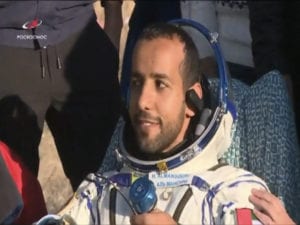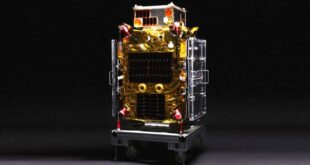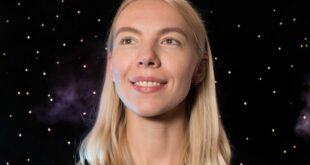
Hazzaa Al Mansoori, the first Emirati astronaut, along with astronauts Nick Hague and Aleksey Ovchinin, returned to Earth safely, after completing his eight-day scientific mission aboard the International Space Station (ISS). The hatch closing of the Soyuz MS-12 took place at 8:20 am UAE time.
The spacecraft undocked from the ISS, on 3 October 2019, at 11:37 am UAE time, and landed in the southeast of Dzhezkazgan in Karaganda Region, Kazakhstan at 2:59 pm.
Al Mansoori was received by Engineer Salem Al Marri, head of the UAE Astronaut Programme, as well as Saeed Karmostaji, the Astronauts office manager at MBRSC, and a specialised international medical team. The astronauts were then taken to a health camp.
H.E. Hamad Obaid Al Mansoori, Chairman of the Mohammed bin Rashid Space Centre (MBRSC), H.E. Yousuf Hamad Al Shaibani, Director General of MBRSC and team members from MBRSC, followed the landing procedure of Hazzaa and his crew mates from the Roscosmos Mission Control Centre (MCC) in Moscow.
Cosmonauts Ovchinin and astronaut Al Mansoori were then transferred to Yuri Gagarin Cosmonaut Training Centre (GCTC) in Star City, Moscow, where Dr. Hanan Al Suwaidi, the flight surgeon for the mission, did a medical check on Hazzaa.
New success story
His Excellency Hamad Obaid Al Mansoori said, “Today, we are proud to welcome the UAE’s ambassador to space, Hazzaa Al Mansoori, back to Earth. He carries with him knowledge, experience, and the results of scientific experiments conducted aboard the ISS. These experiments will enrich human knowledge, as well as the global scientific community, and pave the way for Arab youth to have new dreams and ambitions in this leading sector”.
“Today, we kick-start a new era in the UAE’s space sector, with the completion of a new success story for the country. Al Mansoori set off with ‘Zayed’s Ambition’, and raised the UAE’s flag high in space. He became a role model for Arab youth, and paved the way for generations to come,” added Al Mansoori.
His Excellency Yousuf Hamad Al Shaibani, said, “We are witnessing a historic moment in the UAE, with the return of the first Emirati astronaut, safely back to earth. The success of this mission confirms our ability to turn our dreams into reality. It also proves that we are able to revive Arab civilisation, and we believe that there are no limits to the ambitions and aspirations of Emiratis”.
“I would like to extend our sincere appreciation and gratitude to our wise leadership, which provided all the necessary resources to establish a strong national space sector. I’d also like to thank and commend the efforts of all who took part in making this mission a successful one, notably Hazzaa Al Mansoori and Sultan Al Neyadi, our two Emirati astronauts, as well as our strategic partners, the global space agencies, and the team of Emirati youth from MBRSC. We pledge our wise leadership to continue to make more achievements in the space sector,” added Al Shaibani.
Salem Al Marri said: “The objectives of the UAE Astronaut Programme are well achieved with the success of the first UAE manned mission to space. Hazzaa’s mission will be a cornerstone for successful case studies, to ensure knowledge transfer and capacity building processes are in place for the next generation of astronauts.”
He added, “This mission wouldn’t have been successful without the efforts of a big team at MBRSC; a team that handled all aspects of this mission in a zero-error environment; the scientific team who planned the experiments for the mission, as well as the ground stations team in Dubai, Moscow and Houston who made communicating with Hazzaa possible; and the administration team who managed all details of the mission; those and our local partners in UAE are all a fundamental part of the success of the mission.”
Landing
Al Mansoori returned to earth aboard the Soyuz MS-12, along with Nick Hague and Aleksey Ovchinin, who were at the ISS since March 2019.
MBRSC explained that the undocking took place on 3 October, around 3.5 hours before the touchdown on Earth.
The spacecraft began the deorbit burn to ensure that its speed reached 128 metres per second. After two and a half hours in solo flight, when the Soyuz was around half an orbit from its landing site, the spacecraft oriented itself, tail first, in preparation for a braking manoeuvre, over the Southern Pacific and the Atlantic, near the southern tip of South America.
MBRSC said that, 30 minutes before landing, the three modules of the Soyuz MS-12 separated at an altitude of 140 kilometres: the descent module with the crew headed for landing, while the two other compartments burned up in the atmosphere. At that point, the cover of the parachute container was jettisoned, the main parachute opened at an altitude of 10.7 kilometres, and the braking parachute was jettisoned. When the main parachute was fully deployed, the reentry capsule entered a stable descent with a speed of around 7.2 meters per second.
At an altitude of between 1.1 and 0.8 metres from Earth, the Kaktus altimeter issued a command for the firing of the braking solid motors, DMP, and a giant parachute of 10,767 m2 area launched to slow down the speed of the spacecraft to 7m/sec. The spectacular firing took place around 0.7 meters above the surface, reducing the descent speed of the capsule to between 1.5 meters per second, leading to a smooth and quiet touchdown, north east of Baikonur Cosmodrome.
UAE Astronaut Programme
The mission is part of the UAE Astronaut Programme, which is overseen by the Mohammed bin Rashid Space Centre (MBRSC). The UAE Astronaut Programme is the first integrated programme in the Arab region to prepare national cadres to participate in human space flights and carry out various scientific missions, in addition to becoming a part of the research carried out by the global scientific community to devise solutions to many challenges facing humanity.
The UAE Astronaut Programme is funded by the ICT fund of the Telecommunications Regulatory Authority (TRA). Launched in 2007, this fund, which is the first of its kind in the Arab world, aims towards supporting research and development within the ICT sector in the UAE, helping it to grow into a nationally significant industry with a leading place in the world.
 SpaceWatch.Global An independent perspective on space
SpaceWatch.Global An independent perspective on space




